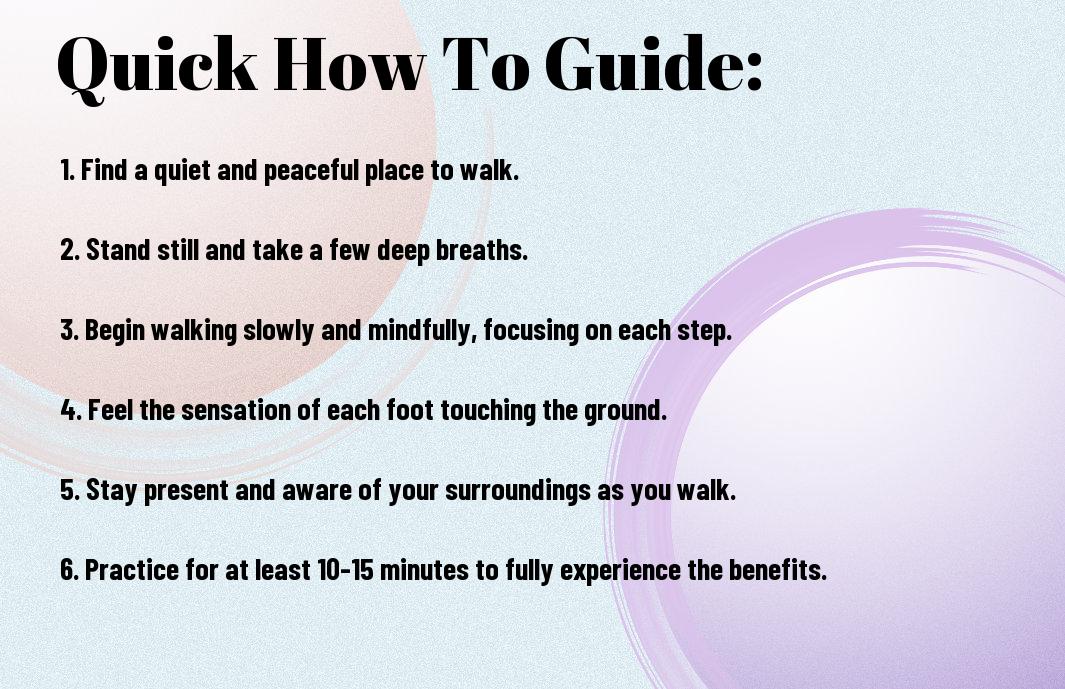Enrich your mindfulness practice by incorporating walking meditation into your routine. Walking meditation provides a unique blend of movement and stillness, helping to cultivate a deeper sense of presence and awareness. In this blog post, I’ll share with you the essential steps to practice walking meditation effectively, including proper posture, breathing techniques, and intention setting. By the end of this post, you’ll be equipped with the tools and knowledge to embark on a transformative journey through walking meditation.
Key Takeaways:
- Focus on the present moment: When practicing walking meditation, the key is to shift your attention to the sensations of each step, allowing your mind to be fully present and mindful.
- Pay attention to your body: Notice the physical sensations of walking, the movements of your muscles, and the contact of your feet with the ground. This helps to ground you in the present moment.
- Cultivate mindfulness in everyday activities: Walking meditation can be a way to integrate mindfulness into your daily life, as you can practice it while walking to work, taking a break, or simply going from one place to another.

How to Start Walking Meditation
Obviously, the first step to practicing walking meditation is to find a suitable location. This could be a quiet park, a peaceful beach, or simply a quiet street in your neighborhood. Once you have found the perfect spot, it’s time to prepare yourself for the practice.
Selecting the Right Place for Practice
When selecting a location for your walking meditation, look for a place that is serene and free from distractions. It should be somewhere safe and peaceful where you can walk without interruption. This will help you to fully immerse yourself in the practice and experience the benefits of walking meditation. Find a place that allows you to connect with nature and feel at ease.
Prepping Yourself for the Practice
Before starting your walking meditation, it’s important to take a few moments to prepare yourself. Wear comfortable clothing and shoes that allow you to walk easily. Take a few deep breaths and clear your mind of any distractions. This will help you to focus on the present moment and fully engage in the practice. It’s also a good idea to set an intention for your meditation, whether it’s to find peace, reduce stress, or simply enjoy the experience.
Tips to Improve your Walking Meditation Practice
Your walking meditation practice can be improved with some simple tips. Here are a few things you can do to enhance your experience:
- Focus on your breathing: Pay attention to your breath as you walk. It can help you stay present and centered during your practice.
- Be mindful of your surroundings: Take in the sights, sounds, and sensations around you as you walk. This can help you stay grounded and connected to the present moment.
- Set an intention: Before you begin walking, set an intention for your practice. Whether it’s to find peace, cultivate gratitude, or simply be more present, having a clear intention can enhance your experience.
After I have written on walking meditation, you can learn more about How to Practice Walking Meditation on LionsRoar.com for further guidance.
Focusing on Your Body Movements
When practicing walking meditation, focus on the sensations in your body as you move. Notice the shifting of your weight from one foot to the other, the movement of your legs, and the placement of your feet on the ground. Paying attention to these physical sensations can help anchor you in the present moment and deepen your practice.
Establishing a Regular Practice
To improve your walking meditation practice, it’s important to establish a regular routine. Set aside time each day for your practice, even if it’s just a few minutes. Consistency is key in cultivating a strong meditation practice. By making it a regular part of your day, you can experience the full benefits of walking meditation.
Factors Affecting your Walking Meditation Practice
Lastly, I want to discuss the various factors that can affect your walking meditation practice. It is important to be aware of these factors in order to ensure that you are able to fully benefit from the practice.
- Influence of External Distractions
- Mental and Emotional Factors
- Physical Factors
This Quora thread delves into the question of whether one can exclusively practice walking meditation and still reap the same benefits as sitting meditation.
Influence of External Distractions
When practicing walking meditation, external distractions can have a significant impact on your ability to focus and remain present. Noise, visual stimuli, and interruptions can disrupt the flow of your practice, making it more challenging to achieve a state of mindfulness. It is important to find a quiet, peaceful environment where you can minimize external disturbances and fully engage in the practice.
Mental and Emotional Factors
During walking meditation, mental and emotional factors can greatly influence your experience. Stress, anxiety, and racing thoughts can make it difficult to stay grounded and attentive. It is essential to recognize these factors and work on cultivating a calm, focused mindset before engaging in walking meditation. Emotional awareness and self-compassion are also important aspects to consider, as they can contribute to a more enriching practice. This Quora thread discusses the potential benefits of exclusively practicing walking meditation.
Physical Factors
Physical factors such as fatigue, discomfort, and physical limitations can impact your walking meditation practice. It is crucial to be mindful of your physical well-being and make any necessary adjustments to ensure that you are able to comfortably engage in the practice. Proper posture, breathing, and alignment are important considerations that can contribute to a more effective and enjoyable walking meditation experience. This Quora thread explores the potential benefits of walking meditation compared to sitting meditation.
Conclusion
Upon reflecting on the practice of walking meditation, I have found it to be a valuable tool for promoting mindfulness and reducing stress. By focusing on the sensations of each step and maintaining presence in the moment, you can cultivate a sense of inner peace and calm. It allows you to connect with your body and breath, and can be a powerful complement to sitting meditation. With consistent practice, you can integrate walking meditation into your daily routine and experience its many benefits for your overall well-being.
FAQ
Q: What is walking meditation?
A: Walking meditation is a form of meditation in action that involves being fully present and mindful while walking. It is usually practiced at a slower pace than regular walking and focuses on the sensations and movements of the body.
Q: How do I practice walking meditation?
A: To practice walking meditation, find a quiet and spacious area where you can walk uninterrupted. Begin by standing still and taking a few deep breaths to center yourself. Then, start walking at a slow and deliberate pace, paying attention to the sensations in your feet and legs as they move. Maintain a steady and rhythmic pace, and if your mind starts to wander, gently bring your focus back to the present moment and the act of walking.
Q: What are the benefits of walking meditation?
A: Walking meditation can help reduce stress, improve focus and concentration, and promote a sense of calm and well-being. It also provides physical exercise and can improve balance and coordination. Additionally, it allows for a more dynamic form of mindfulness practice, as it integrates meditation into everyday activities.

